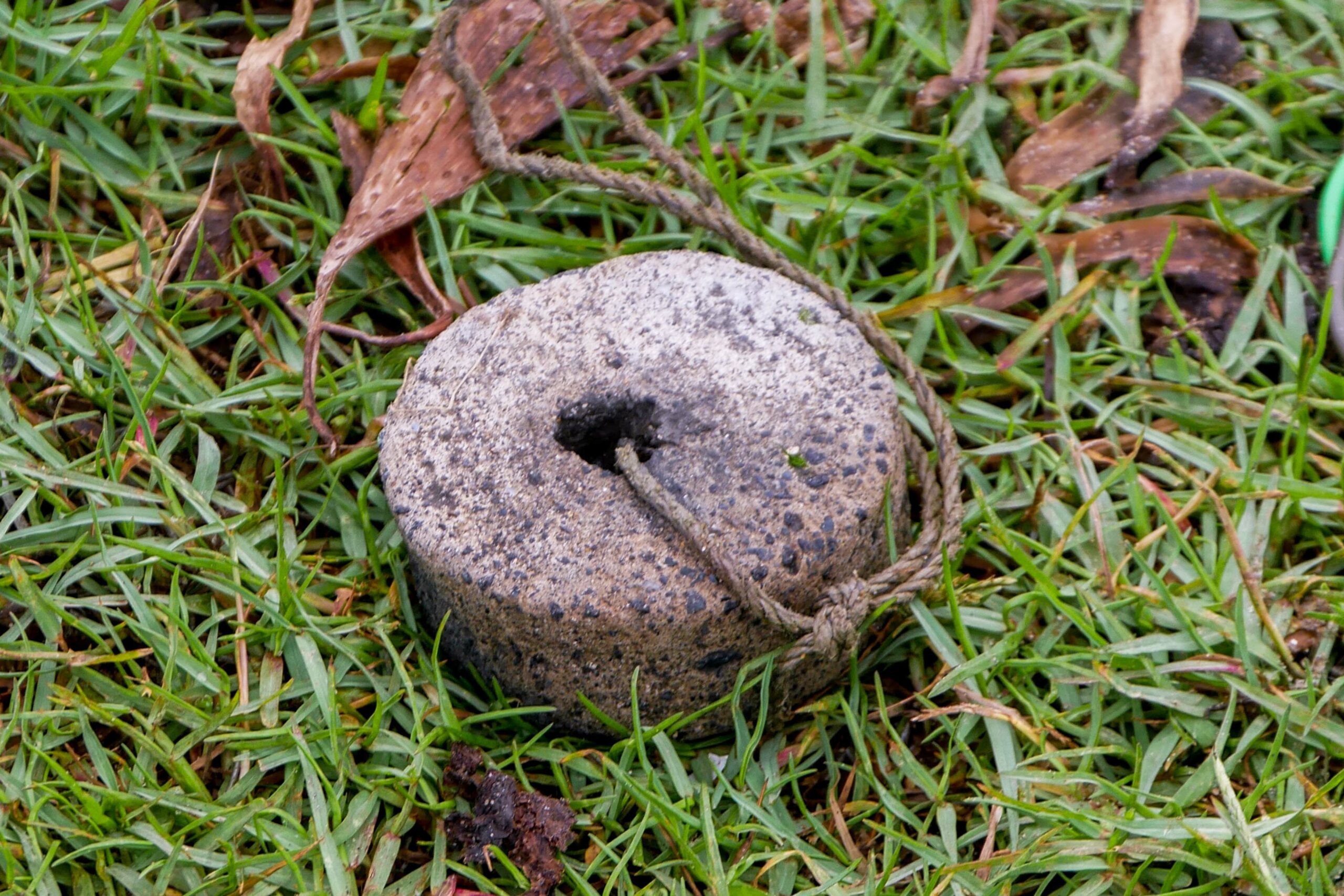Fishing Industry at Munambam
Everyday Life in a Trawling Harbour
Visiting the Munambam harbour at Ernakulam district at the end of July, fishing trawlers lie docked along the wharves, some locked down, others undergoing cleaning and maintenance. This happens every year in the monsoon, when in June and July, trawling is banned on the Kerala coast.
At this time, fisherfolk in the area were getting ready to return to the sea. Then, on midnight of August 1, boats set out on their first trip in weeks. It was almost a race to see which boat would reach the fishing grounds first.
Some of the fisherfolk burst crackers on their way out of the harbour. The entire atmosphere was electric and filled with anticipation. One of the boat owners said, “Whoever gets back the earliest with the catch will get to sell to the highest bidder.”
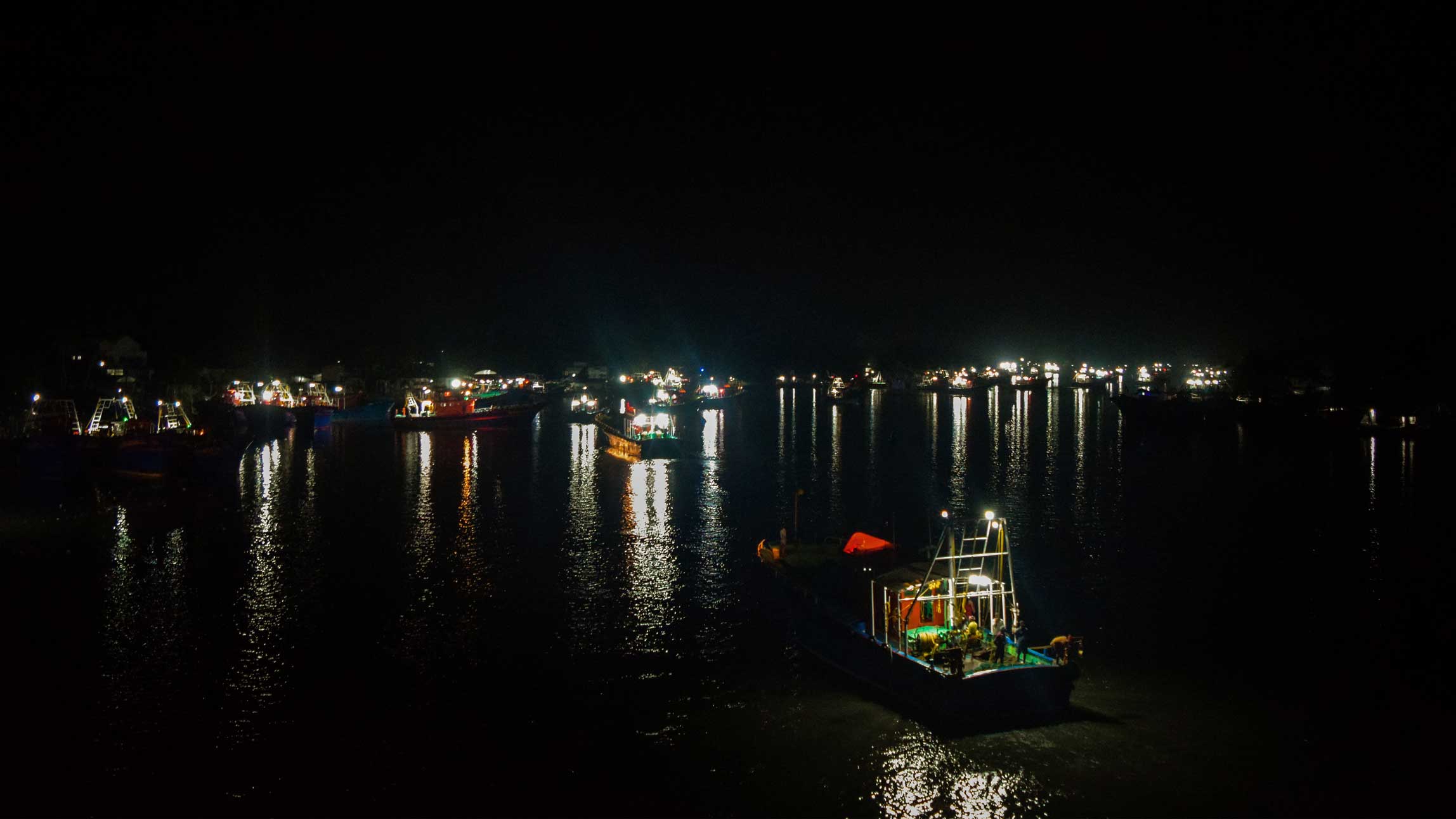
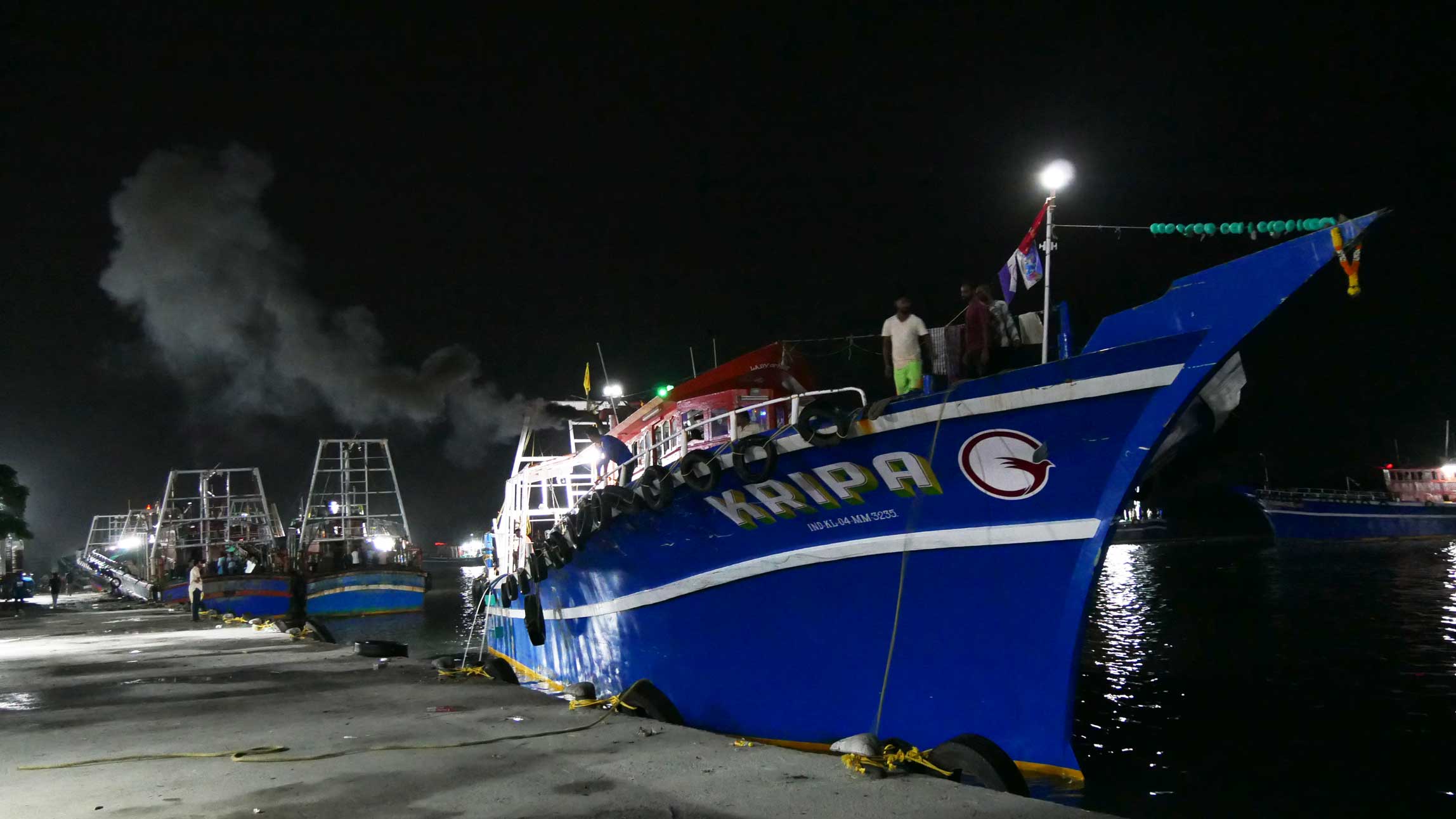
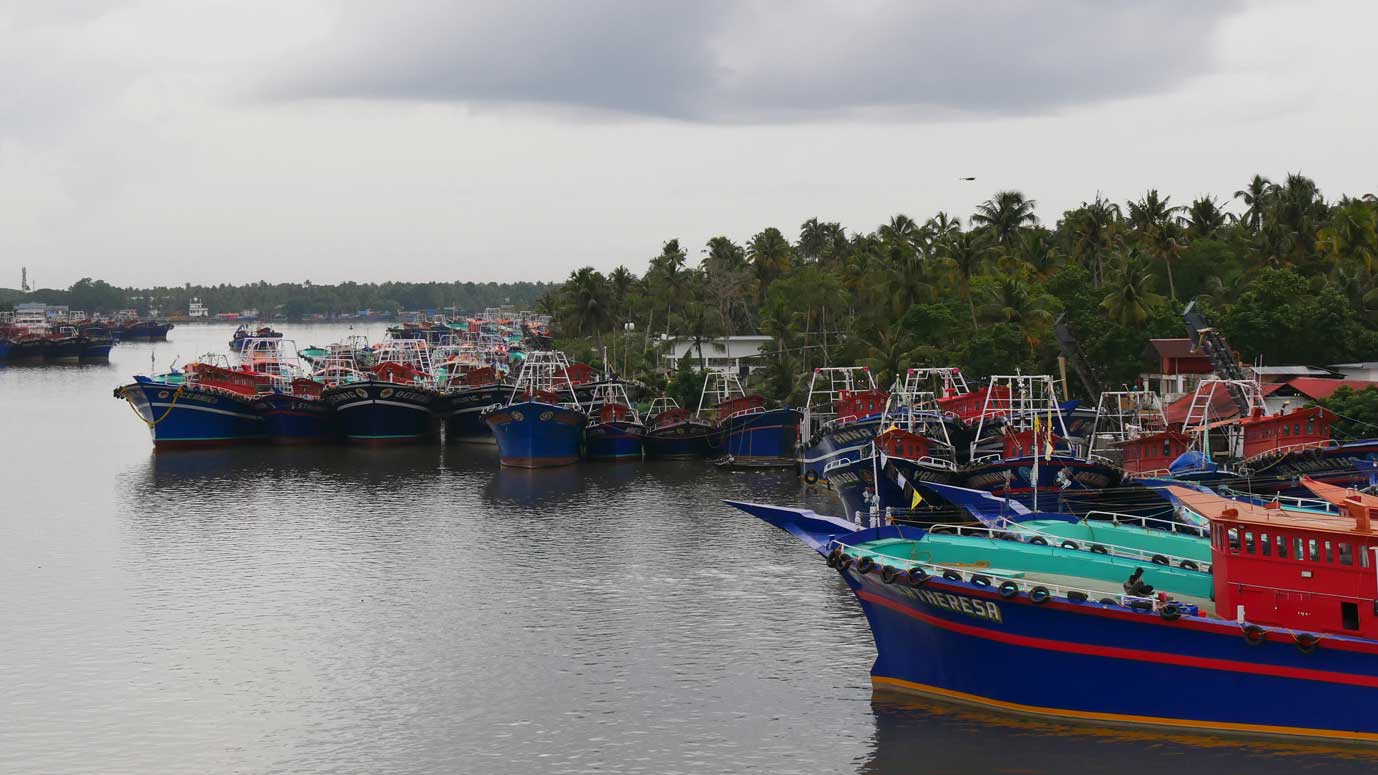
Munambam, located in Kerala, is a significant hub for building trawling boats. The boats made in Munambam boat yards are supplied to Tamilnadu, Karnataka, and occasionally Goa.
There are two harbours in Munambam, the main harbour and the Mini-Harbour, located towards Pallipuram.
In Kerala, fishing was mainly done by small-scale artisanal fishermen using traditional boats and gear until the mid-twentieth century. These fishing communities lived in coastal villages and had collective rights to fish inshore and in coastal waters. The men focused on catching fish while the women processed and sold the catch. Most households owned small canoes for fishing on small scale. Many fishermen worked as crew members on larger boats owned by more affluent individuals within the community.

Evolution of the Off-shore Trawler
The first trawling boats for off-shore fishing, built by the Indo-Norwegian Project in Kollam in 1954, were around 22 ft in length and could stay at sea for 1-3 days. Seventy years later, the trawling boats built in Munambam are as long as 120 ft, with trawl nets as long as 240 ft. Current boats stay at sea for 10-25 days, take on a crew of 15-18 people, and use modern gadgets for navigation and finding fish, besides having large storage space, stronger engines, and winches for the trawl nets.


Do trawlers have number plates?
Trawling boats have a licence number, much like terrestrial vehicles. “The licence is renewed every year,” said Saijan. When this is done, a certain amount of fees must be paid to the government. The licence number would have details of the place of registration and district, like in the case of land vehicles.
Besides the licence number, boats from different states can be identified by the different colours in which they are painted. Trawling boats from Kerala are painted blue, Karnataka boats red, and Tamilnadu boats green.


"Trawling boats made at Munambam use steel frames and MS steel sheets for the hull," ... Unnikrishnan K.K, mesthri.
The use of steel started around 25 years ago, as steel boats were sturdier in rough weather and were not damaged like wooden boats. In addition, steel allowed the installation of powerful engines, and the boats became bigger.
The mesthri, originally Portuguese for ‘master’ architect or boat builder, envisages the plan for the boat. The technique or art of boat-building is handed down from senior boat-builders to juniors, who, after gaining enough experience, graduate to the level of mesthris themselves. Unlike in the past, this transfer of knowledge is not linked to family ties at present.
Each mesthri has his idea about how to build a boat, which has developed over decades. The ‘master architect’ makes minor plan adjustments based on the specifications and requirements of the boat owner(s) and the syrang (captain).
When boats are beached or anchored at the harbour for long periods, like during the monsoon months, inactivity results in issues with the engines or the hull. A few weeks before the trawling ban is lifted, essential repair and maintenance work is carried out in all the boat yards.

Refrigeration - an Essential Resource in Trawler Fishing
Technological development in storage, refrigeration, and ice-making was extremely important in changing trawling methods. Initially, fishermen used to go fishing for 1–3 days as they did not have the means to preserve the catch for a long time. Creating storage on boats was an important development. This required cold storage on board a trawler, ice-making and refrigeration plants, and refrigerated vans for transporting the catch on land.
At Munambam, crushed ice is carried up from the ice containers from the factory to a position above the trawler, from where it is dropped down through the white funnel into the ice store of the trawling boat.
The onboard cold storage facility allows trawling boats to fish offshore for 10–25 days and goes as far as Goa and Kanyakumari.
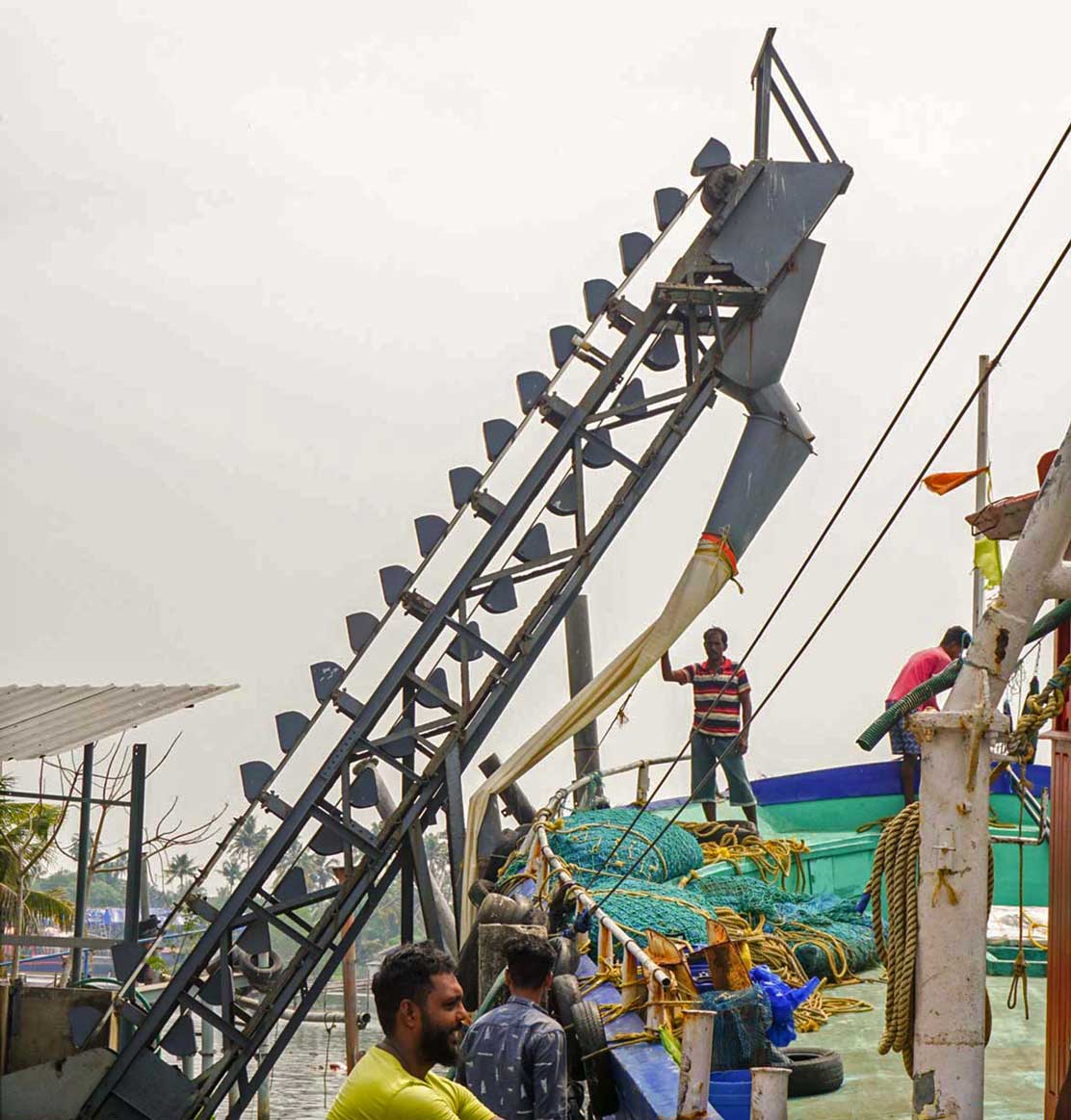

The Cabin - a Trawler's Nerve Centre
The control centre of the trawling boat is the wheelhouse, called the cabin by the fisherfolk at Munambam. The wheel or helm is the device used to control the boat’s direction. It is connected to the boat’s steering mechanism, allowing the syrang (captain) to turn the vessel. The wheel is connected to the rudder and propellers, which are movable and located at the rear of the boat. The rudder controls the boat’s direction, and the propellers move the boat.


"The main part of the boat is the engine, ask any boat owner."
The sale and repair of engines are done in small garage-cum-office spaces around Munambam. The horsepower of the engines has increased over the years from 140 hp used in the wooden boats to 600 hp in the newer trawling boats. Earlier, Indian-made machines were used, which are now replaced by Chinese-made engines of Weichei in Munambam.
The trawling boats also have a generator for less power-intensive operations like switching on lights if they use fishing rods (large fishing rods with 50–100 hooks) at night and a backup inverter.
Current trawling boats have three power sources used for different purposes, and the idea is to conserve as much fuel as possible due to rising diesel charges.

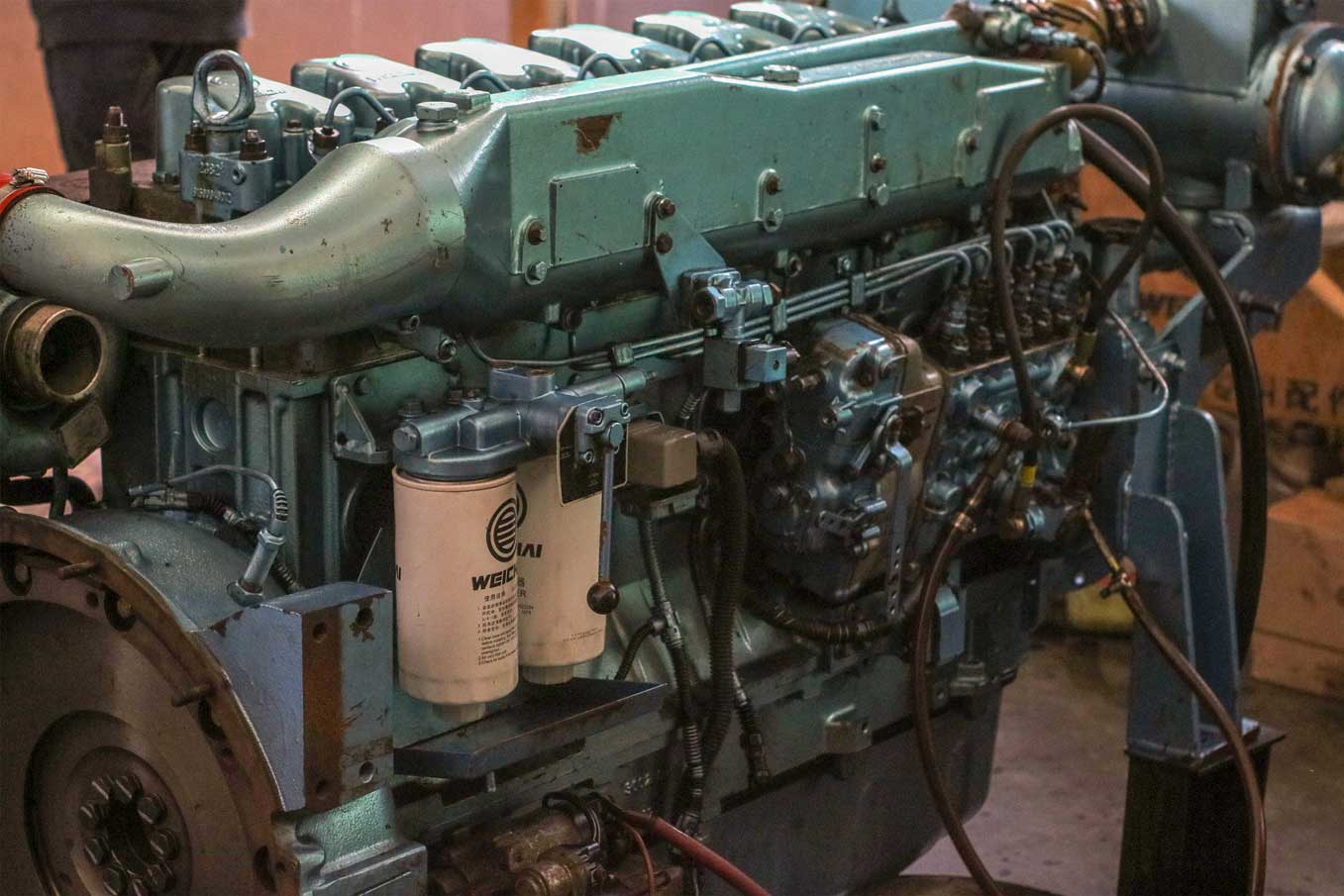
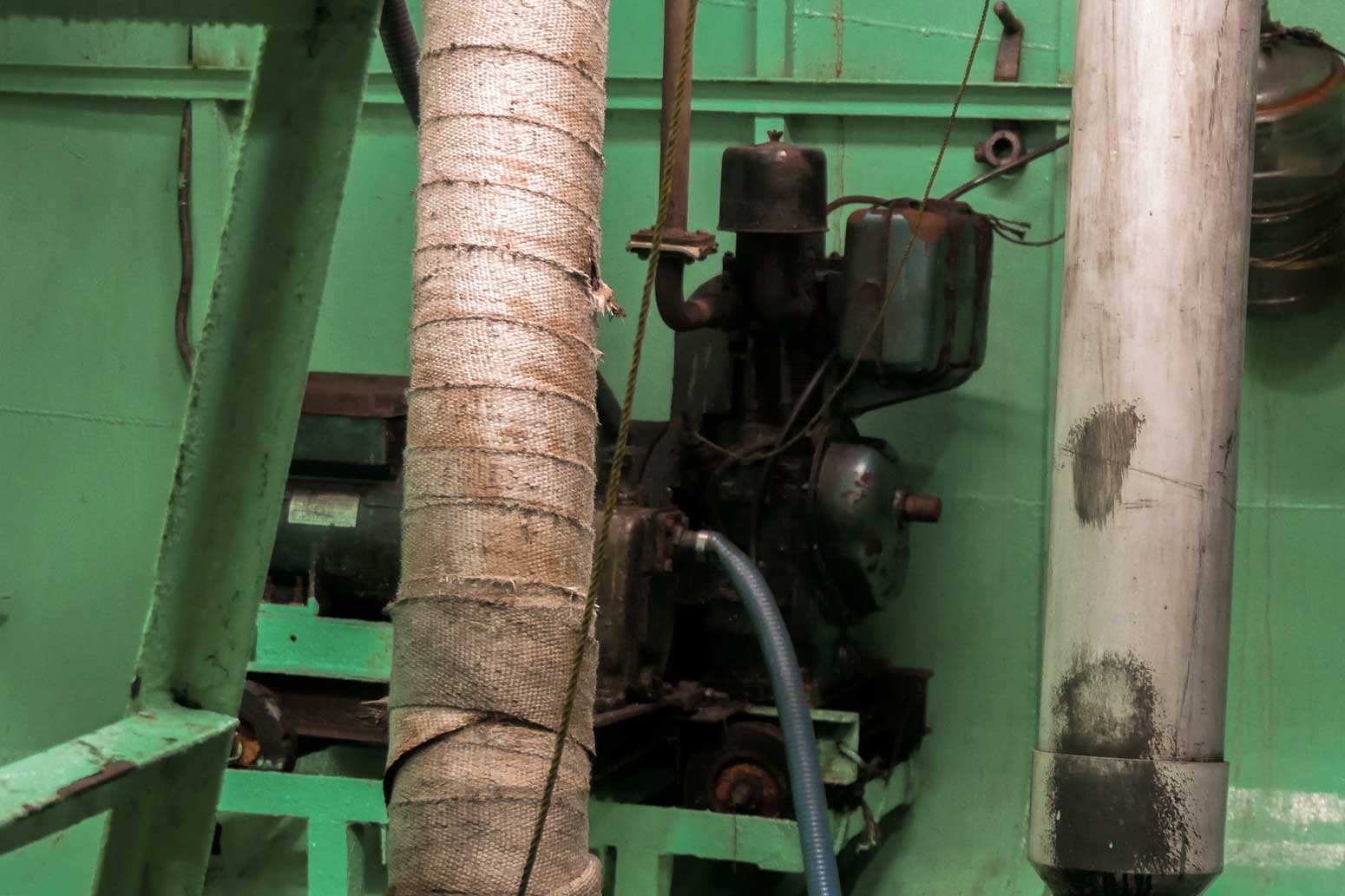
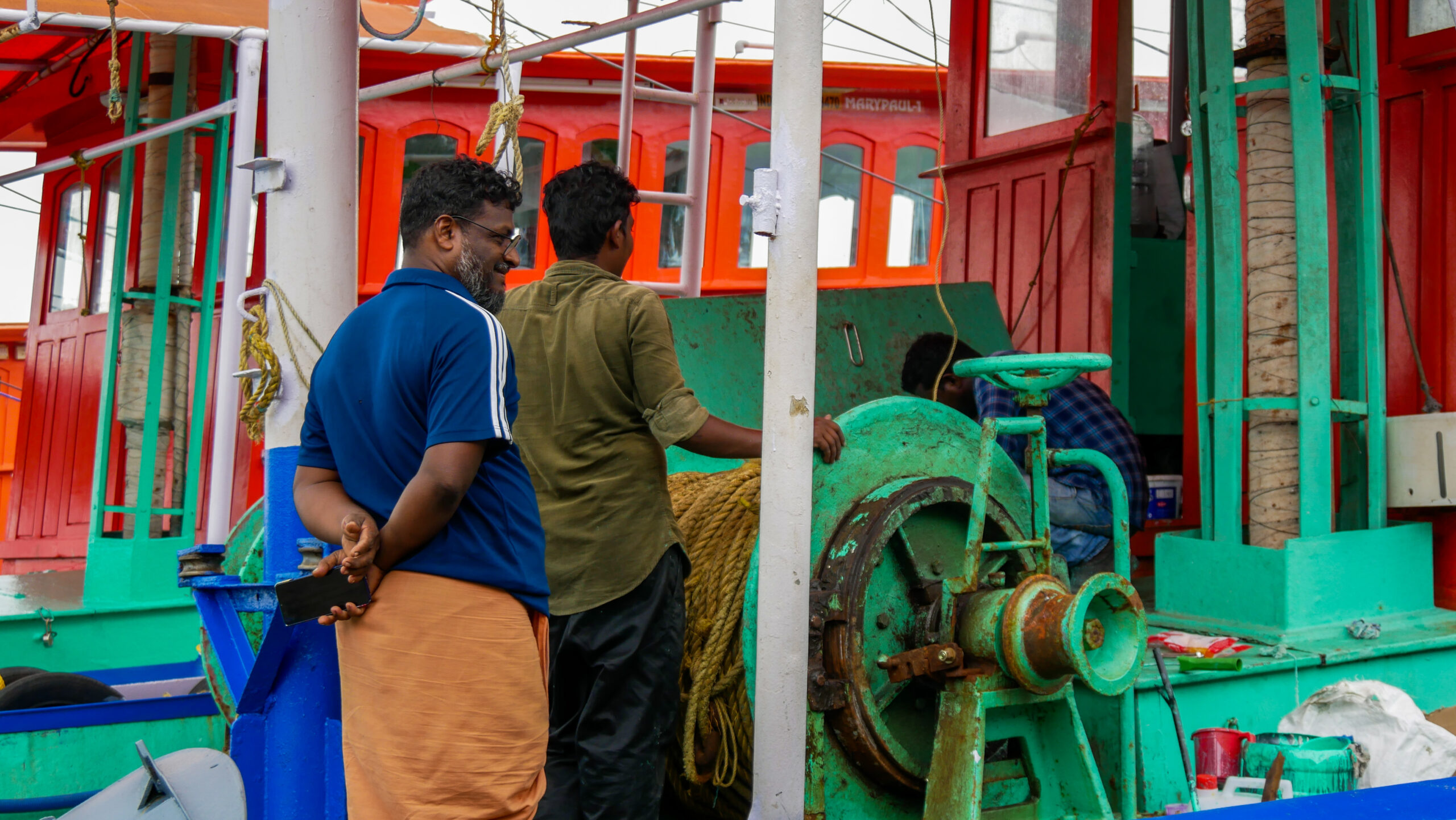
"The winch is used to pull up the net."
The winch rope is made of steel of 11–12 gauge and costs around ₹2.5–3.5 lakhs. It has a plastic coating to stop corrosion. Earlier, the rope had no plastic coating and was greased to stop rusting. The winch mechanism for the net is connected to the powerful engines that in turn rotate the winch and drag the nets through the sea.
“When we find a huge shoal of fish, we call our koottu-boat (boats of friends or common ownership) and relay the GPS location by sea phone. Anyone can listen in to the wireless,” ... Syrang Anthony.
The satellite phone, called a Sea Phone by the fishermen, is a relatively new entrant in the wireless world and used to communicate with other seaborne boats and land stations. Once the boats are away from the shore, mobile phones do not work. Wireless equipment works only if other boats use the same frequency in the vicinity. Sea phones, each with a unique number like a mobile phone, are the only reliable means of communication with other boats and land. They have increased connectivity to land and other boats and changed how fishing networks function.
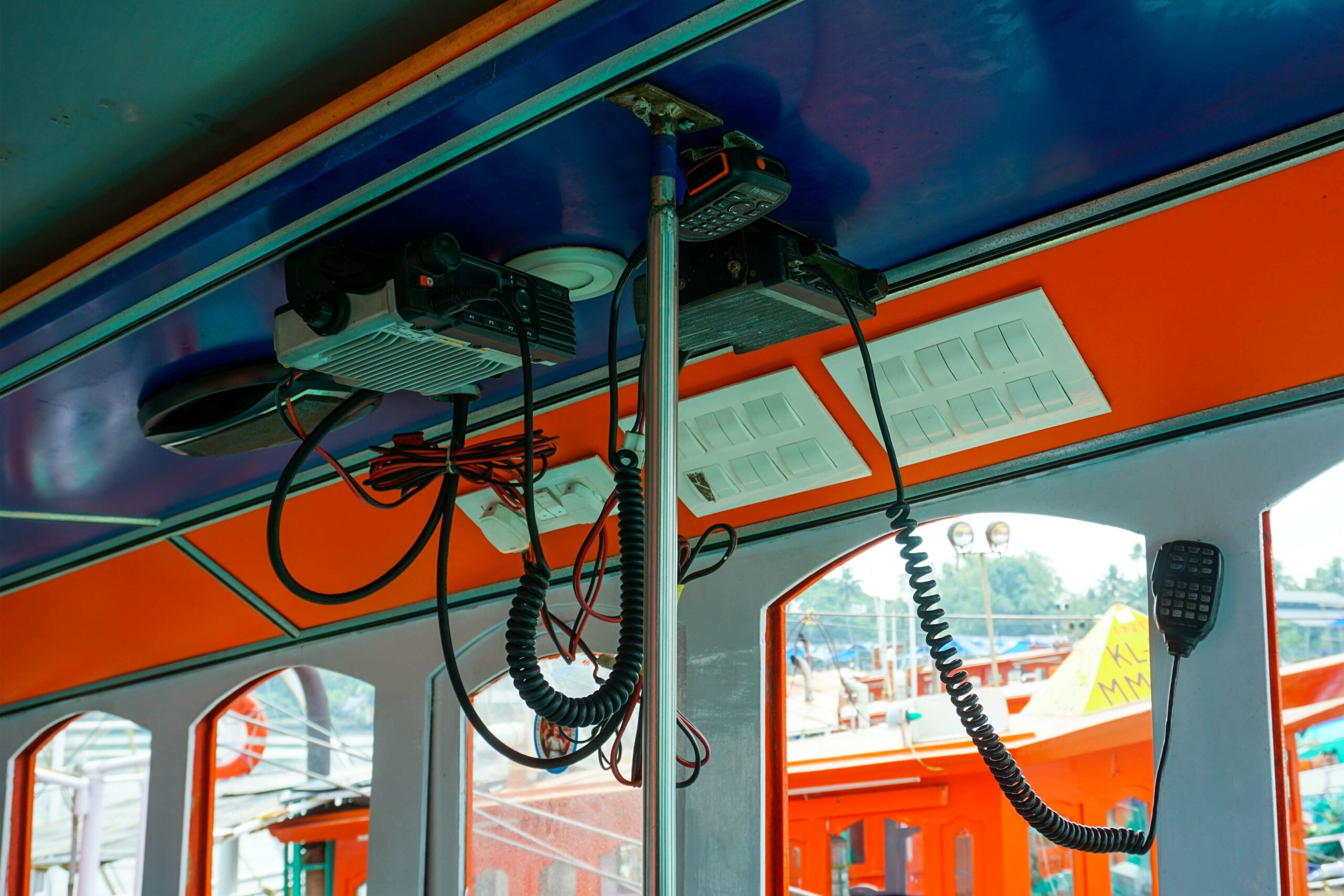
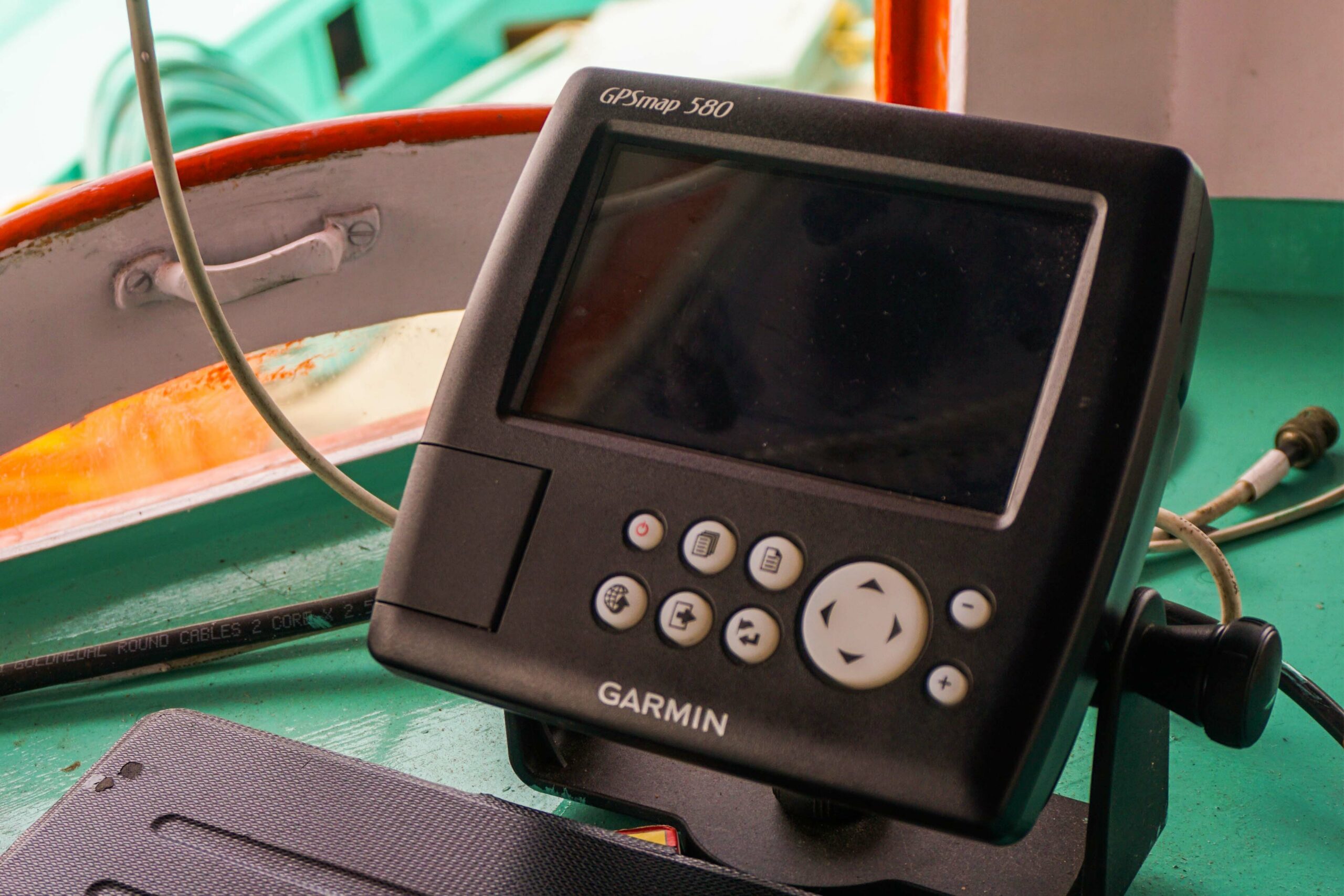

The echo sounder shows shoals of fish and underwater structures, which helps locate fish and navigate the boat. Different companies manufacture echolocators, satellite phones, GPS, and wireless sets; each set or model has unique features. The syrang decides on the make and model of the electronics. The GPS location coordinates are saved in the instrument memory, allowing the fisherfolk to return to a location later. “When we need to meet at the port, we send out “ten-ten”, which is the Munambam location,” mentioned Syrang Anthony.
Two optional devices are in use besides the four pieces of equipment here. The AIF (Automatic Identification System) is necessary for all fishing vessels longer than 20 m for identification and prevention of collision in the ocean. The other is SART (Search and Rescue Transponder), an automatic transmitter and receiver used at sea during an emergency.
Where does the crew live on a trawling boat?
Another function of the cabin or wheelhouse is to house the crew as it is a covered, secure space. The cabin has a bunk-like structure towards the back. The fishermen sleep above and below this space.
The area towards the back is the kitchen or galley. The toilet is towards the back of the galley with an entrance on the starboard side (right). In Kerala, trawling boats are not given licences if no toilet is onboard. The other southern states do not have this rule—the location of the galley and the toilet changes from boat to boat.
There are plug points to power their gadgets, including mobile phones. On the upper left side is the DVD system. Most boats now have a television, DVD, and a music system. The crew brings the latest movies with them on DVDs or pen drives.


What are the functions of the crew?
The syrang (captain) is the most important position within the trawling boat. The edasyrang is the assistant captain who takes over if the main syrang has to be away for some reason. The boat also has an engine driver, who handles the engine, generator, and inverter (charged from the engine) and is required to start the engine. There would be a net specialist (maintenance and storage) and a designated cook. Ten to eighteen workers can stay on a boat and be part of the general crew. The syrang and all the crew take part in sorting and storing fish.
Yet, the syrang is responsible for every critical decision that needs to be taken on a trawling boat, including deciding which firm or shop to order and buy the nets from.


"Very few Malayalis are ready to go on trawling boats," ... boat owners and syrangs.
With access to higher education, the younger generation from fishing families is reluctant to enter the field as fishermen. Many have taken up other jobs like administrative jobs, intermediaries, exporting business, or financing of boats. Today, Malayalis prefer to do shore-based jobs in the fishing industry.
Due to a shortage of workers from Kerala, most of the workers on boats are from Tamilnadu. Many of the fishermen in Munambam come from Colachel, which was originally part of the princely state of Travancore. A daily van service goes from Munambam to Colachel and back.
With the increased access to higher education in Tamilnadu, fewer fishermen are coming from there. Munambam is now getting workers from West Bengal, Orissa, Andhra Pradesh, and other states.
Most of the boats’ syrangs are from Tamilnadu. These are people who had joined the crew as fishermen. They learnt the trade from the Malayali syrangs. Anthony, the syrang of the boat, Friends, is from Colachel in Tamilnadu and added that he has been working in Kerala for 40 years.
"It is the syrang who decides which net to use and what to fish for while at sea." ... Sunil, net shop owner.
The syrang has a very important role in the niche fishing network. For instance, the owners of the trawling boat, ‘Friends’ are getting a new boat built. Anthony, the current syrang, will be the syrang of the new boat. The current edasyrang will become the syrang of Friends when the new boat is launched. Anthony has been chosen because he has been with Friends for 12 years and with the tharakam for 13 years.

Where is the ship’s storage and what is it used for?
Inside the hull, the boat’s front part is used almost entirely for storage. The storage space can carry around 15 tonnes of fish. A special compartment is made within the hull covered in an insulating material called ‘puff’. The puff is made from a combination of chemicals poured into a narrow space or structure built around the storage area. After the puff is set, the fibreglass main compartment is filled with ice. Not all boats use fibreglass for the storage area. The preference for the material used inside the boat varies from boat owner to mesthri.
“While earlier boats used to be made by a single team, today’s trawling boats are made by groups specialised in each kind of work and material,” mentioned Saijan.
There are shelves within the storage compartment. The provisions for the crew are kept in the front part of the storage, and the rest are used to store the catch. The provisions would include what the fishermen called ration (rice, spices, vegetables, fruits, and meat) and bakery items (cakes). The fishermen are given cash from the tharakam to buy food items they prefer.
Filtered or mineral water is used for drinking and cooking and taken along with food supplies. Tanker water is filled in another compartment near the engine room for washing.
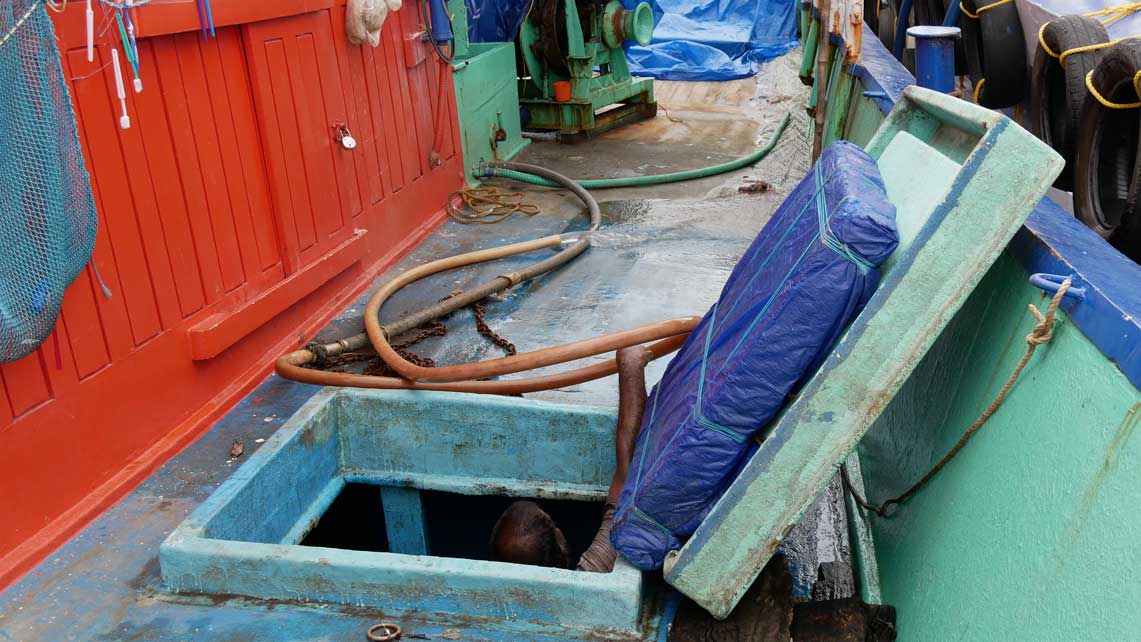

“When I first joined, I wouldn’t come to work without a dupatta." ... Sini, accountant, Mini-Harbour
In fishing communities, women played important roles by helping to make and repair nets. Any extra fish was preserved through traditional drying and curing methods. This preserved fish could be sold later or used for family consumption. These practices and division of work within the fishing communities were sustainable and community-focused. Fishing was a livelihood to meet the food requirements of the family rather than a profitable trade in the past, and there were less than 80,000 active fishermen in the state.
Within the fishing industry, women are mostly seen as accountants taking care of the bookkeeping aspects of the job or running small eateries around the Mini-Harbour. When asked how it felt to work in a male-dominated industry, Sini, one of the first accountants to join the tharakam belonging to Saijan, replied, “When I first joined, I would dress carefully. But now that I’m comfortable at the office, I dress in ordinary clothes.”
The work time of the accountants and bookkeepers is 10–5. The women accountants Sini and Soumya said, “The number of women working in the accounting section of shops or tharakams has increased in the past 4–5 years.” The women were recruited since the boat owners required people to staff the offices after the auction hours (which start at four a.m.). The boat owners cannot handle the business after midmorning due to fatigue caused by the early working hours.

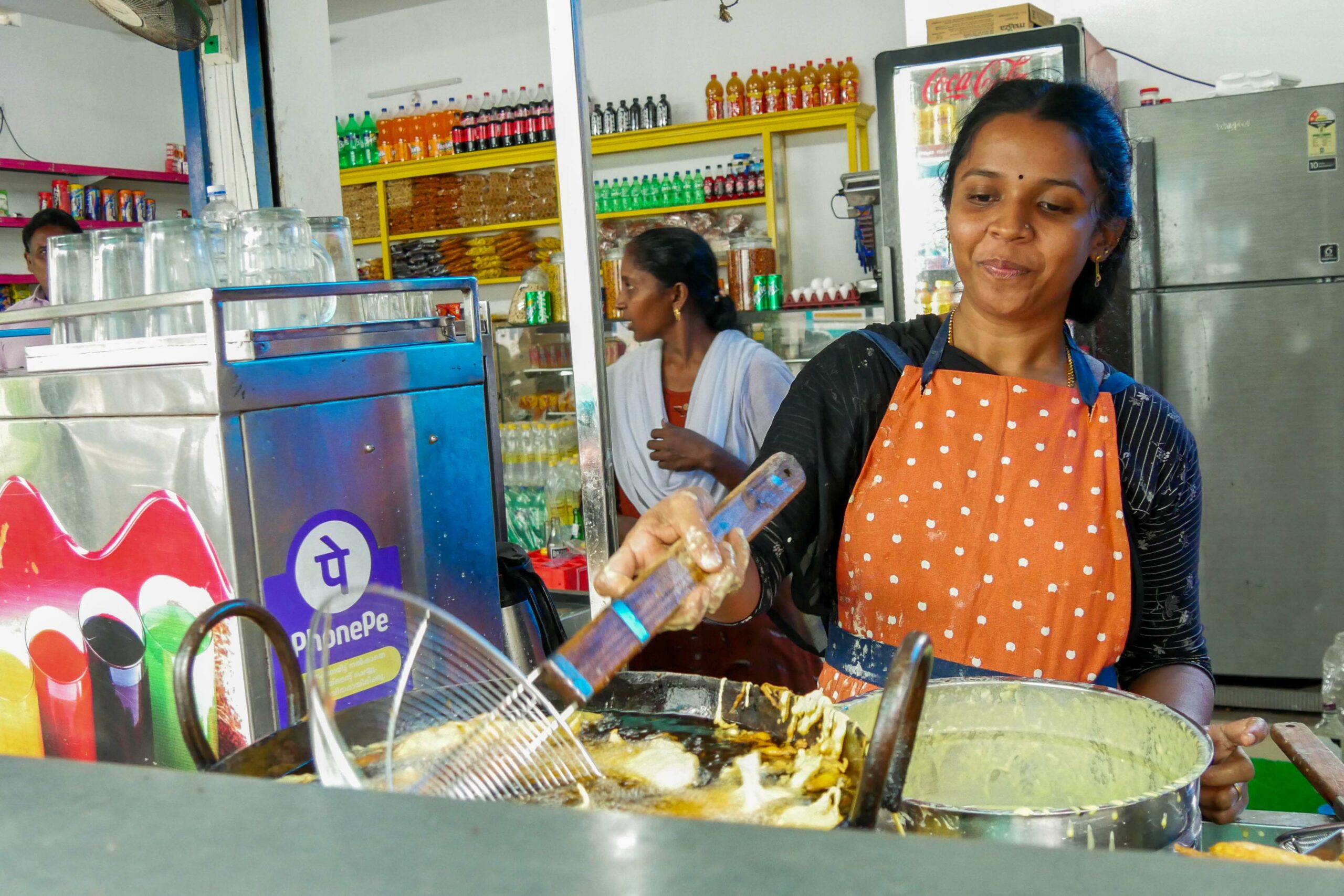
The women accountants felt that the women who used to work in the harbour earlier would have been the fisherwomen (arayathimar) who sold fish from house to house. Sini said, “We live around Paliipuram while the fisherwomen stay around the Munambam area. This could be one of the reasons there are not many of them around the Mini-Harbour.”
Saijan, a trawling boat owner, said, “Women have stopped arriving here to buy fish during the auction for three to four years.”
The other boat owners believe that as the financial situation of the fisher families has improved, women do not need to sell fish to provide for their families. In addition, many family members are now educated, and they do not want to be part of the fishing industry.
The Mahatma Gandhi National Rural Employment Guarantee Act 2005 (MGNREGA) offers women and others from low-income families steady work for 15 days a month. “Because a guaranteed job is available, the women do not have to depend on selling fish,” said the other boat owners.


Financing Fishing Industry and Selling the Fish
“The cash transactions at the office are settled daily at the main tharakam office (the Mini-Harbour Tharak Agents) by afternoon,” said Sini, the accountant at the office. The Mini-Harbour in Munambam is privately owned by the Munambam Mini Fisheries Harbour Tharak Agents Private Limited, a non-governmental company. Saijan and the other boat owners belong to this organisation.
Tharakanmar [middlemen] has a contract with the boat owner to buy and sell the fish from the trawlers. If someone wants to get the business (tharak) from a boat owner, they usually pay an advance when the boat is being built. There would be an agreement that the tharakan is given the monopoly to buy from the boat.
Tharakan is also a commission agent. The tharakan takes and sells the fish, keeps a percentage of the profits, and hands over the money to the boat owner. The tharakan sells it at the market to local fisherfolk, shopkeepers, and market exporters. The auction of the fish happens at the harbour.

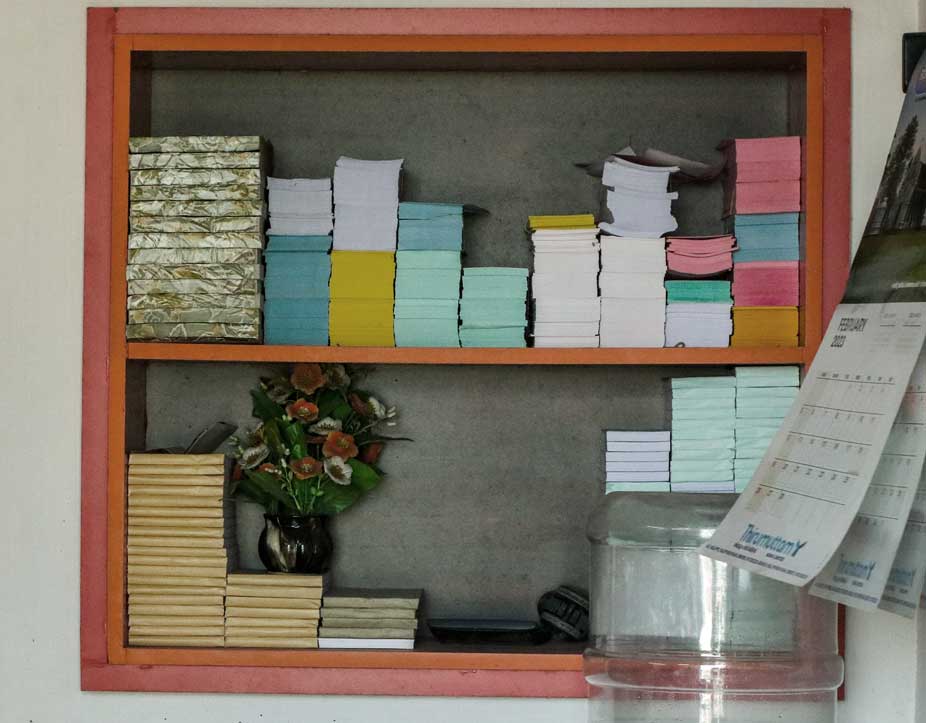
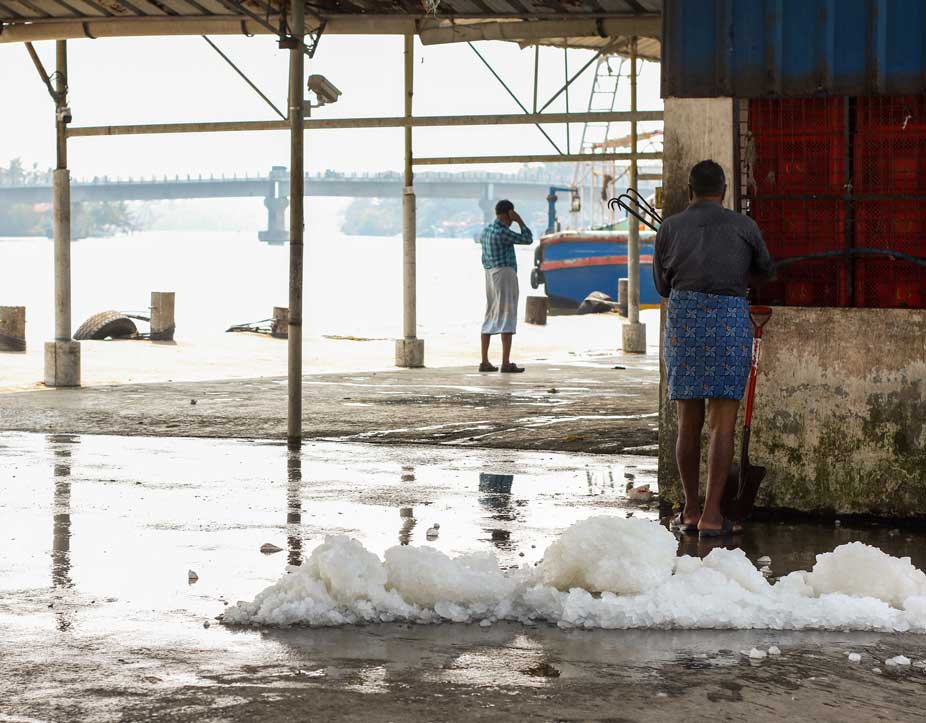

Trawling a.k.a Industrial Fishing and Marine Ecology
Trawling boats have had a difficult relationship with the media, environmentalists, and traditional fishermen in Kerala and worldwide. Advancements in fishing technology and highly mechanised fishing boats have resulted in over-fishing. An 80% decline in certain varieties of fish due to trawling has been noted on the Kerala coast.
Trawling nets catch migratory shoals, eggs, and juvenile fishes, disrupting the replenishment cycle. Trawling has destroyed coral reefs, seagrass beds, and ecologically sensitive regions near shore. From sea floor damage to exploitative fishing, practices like throwing the bycatch or unwanted catch, including endangered species, back into the water have put aquatic life at risk. The destruction of non-target species, around 214 in Kerala, has disrupted the food chain. Only a part of this bycatch is used in the fish drying, curing, and fishmeal industry.
The export of seafood that took off with the Indo-Norwegian Project increased the demand for certain kinds of sea products like prawns, crabs, and lobsters. The increase in the seafood export sector has, therefore, taken away Keralites’ access to certain kinds of fish. The focus of the mechanised fishing industry has moved from food production to trade and, now, foreign exchange at the state and corporate levels.

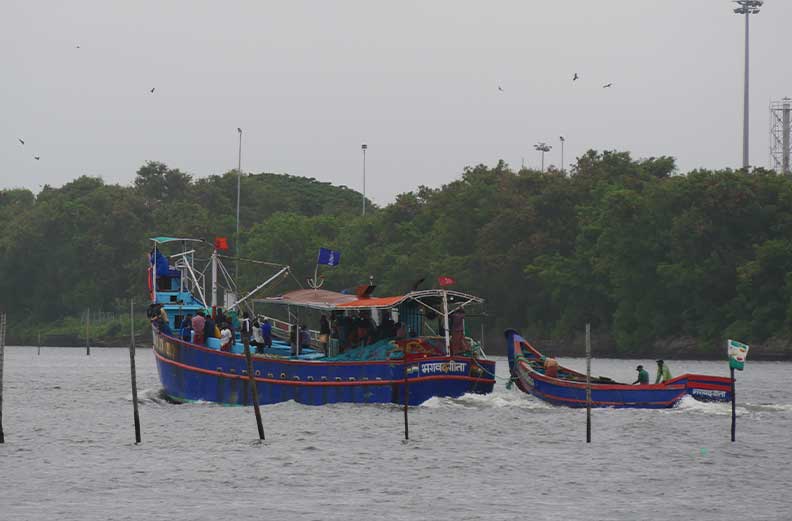
"Catching the small fish affected the replenishment of fish. But, with the trawling ban in the monsoon, that has reduced.' ... Purushan, traditional fisherman, Puthuvype.
The introduction of mechanisation and trawling techniques have impacted traditional fishing and fisherfolk in different places in many ways.
Due to the trawling ban and adverse weather conditions, they were trying their luck fishing in the mangroves around Puthuvype. Purushan, a traditional fisherman, said, “We do not have a problem with the big trawling boats. Earlier, they used pelagic (bottom trawling huge nets) nets, which was not good for the fish. The small fish and unwanted fish would be caught in that net. There would be a lot of waste. Now they do not fish near the shore but in the deep sea. So, we do not see them.”
In the past, the Indo-Norwegian Project attempted to create fishing cooperatives for fishermen, but those did not work. Later, in the late 1970s, the traditional fishermen decided to create their cooperatives with government or church support. These cooperatives helped them get loans to buy fishing boats and equipment, process their catches for the market, and stand up against unfair fishing practices followed by large trawling boats.
